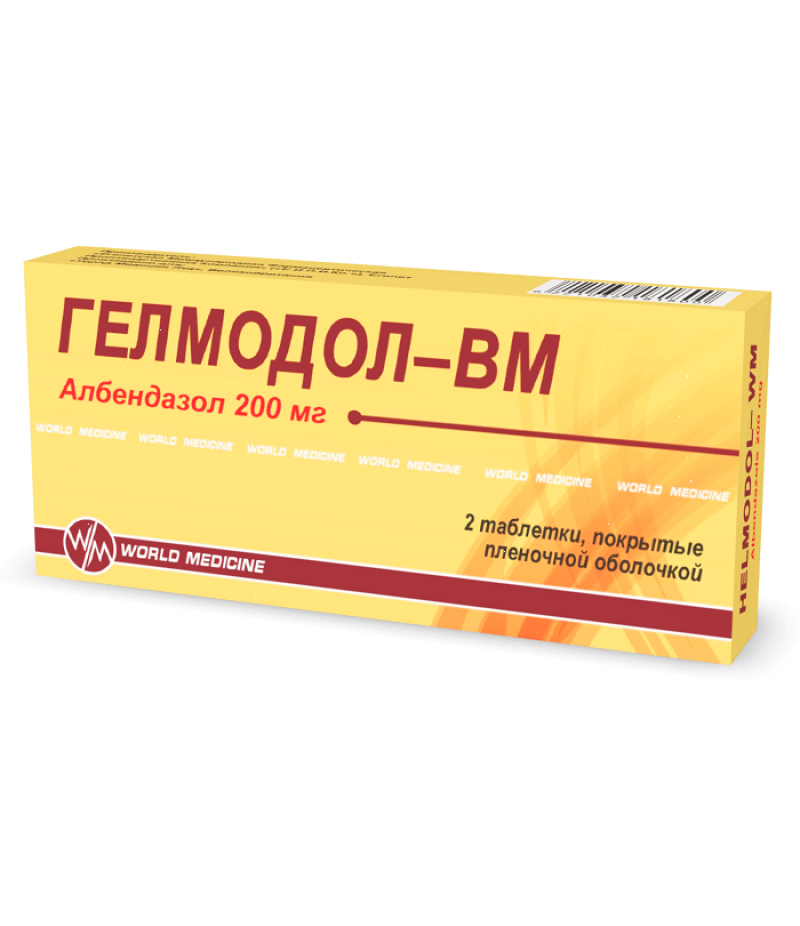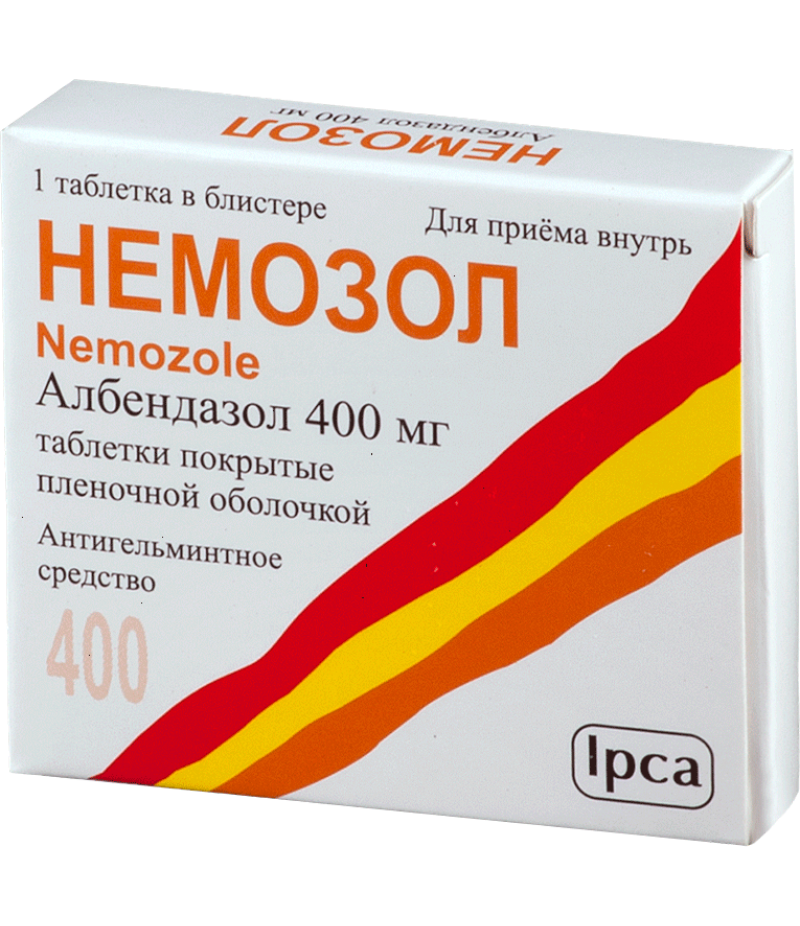Gelmodol-VM tabs 200mg #2
- $16.62
- 3 or more $16.48
- Availability:Out Of Stock
Gelmodol-VM user manualReed more and buy Gelmodol-VM on this pageDosage form, compositiontablets, film-coated.One coated tablet contains:Active substance: albendazole (micronized) -200.0 mgExcipients: lactose monohydrate -164.5 mg..
Tags: tabs
Gelmodol-VM user manual
Reed more and buy Gelmodol-VM on this page
Dosage form, composition
tablets, film-coated.
One coated tablet contains:
Active substance: albendazole (micronized) -200.0 mg
Excipients: lactose monohydrate -164.5 mg, corn starch - 70.0 mg, magnesium stearate-5.5 mg, sodium carboxymethyl starch -10.0 mg, crospovidone-80.0 mg, povidone-17.0 mg, sodium lauryl sulfate 1.0 mg.
Sheath: hypromellose 7.5 mg, macrogol 3.75 mg, titanium dioxide 3.0 mg, purified talc 30.0 mg.
Description: Round, biconvex tablets, covered with a film coating of white or almost white color, with a characteristic odor. The cross-section of the nucleus is white.
Pharmacotherapeutic group
Anthelminthic and antiprotozoal.
ATX Code P02CA03
Pharmacological properties
Gelmodol-VM is an antihelminthic drug whose pharmacological properties are due to the action of the active substance - albendazole. Albendazole belongs to the group of carbamate-benzimidazoles. The mechanism of action of albendazole is its ability to disrupt the activity of the microtubule system of the cells of the intestinal canal of helminths, thus causing damage to the tubulin protein. The consequence of this is biochemical disorders in the cell - the suppression of glucose transport and fumarate reductase, which underlies the suppression of cell division at the stage of metaphase and which is associated with oppression of oviposition and development of helminth larvae.
Albendazole blocks the movement of secretory granules and other organelles in the muscle cells of roundworms, causing their death.
Albendazole is effective against most intestinal nematodes, as well as larval (larval forms) cestodes. Albendazole as an antiparasitic drug has a fairly broad spectrum of action.
Pharmacokinetics
Suction. After ingestion, the drug is poorly absorbed in the gastrointestinal tract, unchanged is not detected in the blood plasma. Bioavailability when ingestion is low. The intake of fatty foods increases absorption and maximum concentration by 5 times.
Metabolism. Albendazole rapidly converts into the liver into the primary metabolite, albendazole sulfoxide, which also has anthelmintic activity.
Distribution. The maximum concentration in the blood plasma of albendazole sulfoxide is reached in 2-5 hours after administration. The metabolite is associated with plasma proteins by 70% and is completely distributed throughout the body: it is found in urine, bile, liver, in the wall and liquid of helminth cysts, cerebrospinal fluid.
Excretion. Albendazole sulfoxide in the liver is converted into albendazole sulfone (secondary metabolite) and other oxidized products. The half-life of albendazole sulfoxide is 8-12 hours. It is excreted in the urine in the form of various metabolites.
The excretion of albendazole and albendazole sulfoxide through the kidneys is insignificant. In patients with impaired renal function, the clearance does not change.
In patients with liver damage, the bioavailability rises, the maximum concentration of albendazole sulfoxide in the blood plasma increases 2-fold, and the half-life increases. Albendazole induces cytochrome CYP1A2 in human liver cells; accelerates the metabolism of many drugs.
Indications for use
Gelmodol-VM is a highly effective anthelmintic and antiprotozoal multivalent drug intended for therapy of the majority of existing helminthiases:
nematodes:
ascaridosis, causative agent - round helminth Ascaris lumbricoidesl;
trichocephalus (withered head), causative agent - round helminth Trichocephalus trichiurus;
enterobiosis (pinworm), causative agent - round helminth Enterobiusvermicularis;
ankylostomidosis (crooked head), pathogens-Ancylostoma duodenale and Necatoramericanus;
trichinosis, pathogens-trichinella meat;
toxocarosis, causative agent -Thosaga canis, parasite of dogs;
Strogyloidosis (intestinal acne), causative agent - round helminth Strongiloidesstrcoralis,
as well as mixed invasions;
tissue cestodiasis:
cysticercosis (causative agent of Cysticercus cellulosus, larval stage of ribbon parasite of pork chain);
hydatidic echinococcosis of the liver, lungs, peritoneum caused by the larval form of the canine tapeworm (Echinococcus granulosus),
also the drug is used as an aid in the surgical treatment of alveolar echinococcosis.
Contraindications
hypersensitivity to the drug components and other benzimidazole derivatives;
deficiency of lactase, lactose intolerance, glucose-galactose malabsorption;
pathology of the retina;
Children under 3 years old (for this dosage form).
Carefully
Preparation Gelmodol-VM with caution used in violations of liver function (it is necessary before and during treatment to regularly monitor liver function), oppression of bone marrow hematopoiesis, liver cirrhosis.
Application in pregnancy and lactation
The drug Gelmodol-VM is contraindicated for use during pregnancy and lactation (breastfeeding).
Pediatric Use
The drug is intended for use in children aged 3 years. Clinical data on the use of albendazole up to 3 years are limited. Children should avoid high doses of albendazole whenever possible for a long time.
Dosing and Administration
The drug is taken orally, during or after a meal. Special training and diet is not required.
The dosage form is chosen individually, depending on the convenience of taking the drug and the tolerability of the substances involved.
The dose of the drug is set individually, depending on the type of infestation, the body weight of the patient.
The maximum daily dose is 800 mg.
In ascariasis, trichocephalosis, Gelmodol-VM is administered to patients with a body weight of 60 kg and more - 400 mg per day, once or twice a day; patients with a body weight of less than 60 kg -15 mg / kg per day in 2 divided doses.
When enterobiosis, the drug is prescribed in a dose of 5 mg / kg body weight once. After 14 days, the course of treatment should be repeated in the same dose and in the same regimen.
When strongyloidosis, ankylostomiasis, Gelmodol-VM is prescribed in a dose of 10 mg / kg body weight once for 3 days. After a week, it is recommended to repeat the treatment cycle in the same doses. With trichinosis, the drug is prescribed at a dose of 10 mg / kg of body weight per day in 2 divided doses for 7-10 days. In cases of severe invasion and organ damage (myocarditis, pneumonitis, meningoencephalitis), glucocorticosteroid and symptomatic agents are also prescribed.
Treatment of toxocariasis. Gelmodol-VM is administered at a dose of 10 mg / kg of body weight per day in 2 divided doses after meals for 10 days. It is required to conduct repeated courses of treatment with an interval of 2 weeks / month. In the process of treatment, peripheral blood control (once every 5-7 days) and aminotransferases at the same time is necessary.
Treatment of hydatidid echinococcosis. Before the appointment of the drug requires a clinical blood test, a biochemical blood test (hepatic-renal complex). Treatment is carried out at normal laboratory parameters. Gelmodol-VM is prescribed in a dose of 10 mg / kg of body weight in 2-3 doses. The duration of the course of treatment is 3 cycles of 28 days with a 14 day break between cycles. During the treatment, blood and aminotransferases are examined every 5-7 days. With a decrease in white blood cells below 3.0x109 / l and a 5-6-fold increase in the level of aminotransferases, treatment should be suspended until normalization or significant improvement in performance. The appointment of hepatopotectors during treatment and in cases of toxic manifestations is ineffective, it is necessary to cancel the drug.
Treatment with chemotherapy for alveolar echinococcosis is an additional remedy. Doses and the mode of prescribing the drug is the same as for hydatidid echinococcosis. The duration and course of treatment is determined by the patient's condition and tolerability of the drug.
For cysticercosis, Gelmodol-VM is given a dose of 15 mg / kg of body weight in 3 divided doses. Duration of the course is 28-30 days. 2 days prior to taking the drug and in the first week of administration, glucocorticosteroid agents are prescribed. Before treatment, during the drug and at the end of the same control as in the treatment of echinococcosis.
Overdose
Symptoms: increased dose-related side effects.
Treatment: gastric lavage, the appointment of activated charcoal, symptomatic therapy.
Side effects
On the part of the digestive system: violations of the liver with changes in functional liver tests (mild or moderate increase in the activity of "liver" transaminases), abdominal pain, nausea, vomiting.
From the hemopoietic system: oppression of bone marrow hematopoiesis (leukopenia, granulocytopenia, agranulocytosis, thrombocytopenia, pancytopenia).
From the cardiovascular system: increased blood pressure.
From the side of the central nervous system: headache and dizziness, meningeal symptoms.
From the side of the urinary system: a change in the indicators of kidney function (acute renal failure).
Dermatological reactions: itching, skin rash.
Allergic reactions: angioedema, immediate-type hypersensitivity reactions.
Other: hyperthermia, alopecia.
Interaction with other medicinal products
Dexamethasone and cimetidine increase the concentration of albendazole sulfoxide in the blood.
special instructions
It is recommended to monitor the cellular composition of the blood; When leukopenia occurs, the drug is stopped.
At women of childbearing age before the beginning of treatment spend the test for absence of pregnancy. During therapy, reliable contraception is necessary.
It should be remembered that before the appointment of Gelmodol-VM, as well as any other anthelmintic preparation, you should carefully clean the room, wash the children's toys, before going to bed and after a shower and change your underwear. Bed linen is advisable during the days of treatment and a few days after taking the drug iron it with a hot iron.
Influence on ability to drive vehicles, mechanisms
Gelmodol-VM does not affect the ability to drive a car and perform work that requires a high rate of psychomotor reactions.
Form of issue
Tablets, film-coated 200 mg.
2 tablets in a blister of PVC-aluminum foil.
One blister, along with instructions for use, is placed in a cardboard box.
Storage conditions
Store at a temperature of 15 to 25 ° C.
Keep out of the reach of children.
Shelf life - 3 years.
Do not use after the expiration date.
Conditions of leave from pharmacies
You don't need a prescription to buy Gelmodol-VM.


